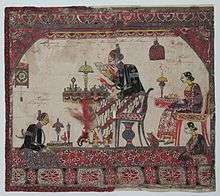Diponegoro
| Pangeran Diponegoro | |||||
|---|---|---|---|---|---|
|
Portrait of Prince Diponegoro, 1835 | |||||
| Born |
11 November 1785 Yogyakarta Sultanate | ||||
| Died |
8 January 1855 (aged 69) Oedjoeng Pandang, Dutch East Indies | ||||
| Spouse |
Kedhaton Ratnaningsih Ratnaningrum | ||||
| Issue | 17 sons and 5 daughters | ||||
| |||||
| House | Hamengkubuwana | ||||
| Father | Hamengkubuwana III | ||||
| Mother | Mangkarawati | ||||

(Collection Leiden University Library)
Diponegoro (Mustahar; Antawirya; 11 November 1785 – 8 January 1855),[1] also known as Dipanegara, was a Javanese prince who opposed the Dutch colonial rule. He played an important role in the Java War (1825–1830). In 1830, the Dutch exiled him to Makassar.
Early life
Diponegoro was born on 11 November 1785 in Yogyakarta, and was the eldest son of Sultan Hamengkubuwono III of Yogyakarta. When the sultan died in 1814, Diponegoro was passed over for the succession to the throne in favor of his younger half brother, Hamengkubuwono IV (r. 1814-1821), who was supported by the Dutch. Being a devout Muslim, Diponegoro was alarmed by the relaxing of religious observance at his half brother's court, as well as by the court's pro-Dutch policy.
In 1821, famine and plague spread in Java. Hamengkubuwono IV died, leaving only an infant son as heir. When the year-old boy was appointed as Sultan Hamengkubuwono V, there was a dispute over his guardianship. Diponegoro was again passed over, though he believed he had been promised the right to succeed his half brother.[2] This series of natural disasters and political upheavals finally erupted into full-scale rebellion.[3]
Rebellion against the Dutch
Dutch colonial rule was becoming unpopular among local farmers because of tax rises, crop failures and among Javanese nobles because the Dutch colonial authorities deprived them of their right to lease land. Because the local farmers and many nobles were ready to support Diponegoro and because he believed that he had been chosen by divine powers to lead a rebellion against the Christian colonials, he started a holy war against the Dutch. Dipenogoro was widely believed to be the Ratu Adil, the Just Ruler predicted in the Pralembang Joyoboyo.
The beginning of the war saw large losses on the side of the Dutch, due to their lack of coherent strategy and commitment in fighting Diponegoro's guerrilla warfare. Ambushes were set up, and food supplies were denied to the Dutch troops. The Dutch finally committed themselves to controlling the spreading rebellion by increasing the number of troops and sending General De Kock to stop the insurgency. De Kock developed a strategy of fortified camps (benteng) and mobile forces. Heavily-fortified and well-defended soldiers occupied key landmarks to limit the movement of Diponegoro's troops while mobile forces tried to find and fight the rebels. From 1829, Diponegoro definitively lost the initiative and he was put in a defensive position; first in Ungaran, then in the palace of the Resident in Semarang, before finally retreating to Batavia. Many troops and leaders were defeated or deserted.
Defeat and exile

In 1830 Diponegoro's military was as good as beaten and negotiations were started. Diponegoro demanded to have a free state under a sultan and wanted to become the Muslim leader (caliph) for the whole of Java. In March 1830 he was invited to negotiate under a flag of truce. He accepted but was taken prisoner on 28 March despite the flag of truce. De Kock claims that he had warned several Javanese nobles to tell Diponegoro he had to lessen his previous demands or that he would be forced to take other measures.[4] The Dutch exiled him to Makassar.
Legacy
Today Diponegoro is a National Hero of Indonesia, and Kodam IV/Diponegoro, the Central Java Military Region, is named after him. The Indonesian Navy has named two ships after him. The first of these was the lead ship Diponegoro: a (SIGMA-Class) corvette purchased from the Netherlands. The most recent is the KRI Diponegoro-365,
References
- ↑ "Sasana Wiratama: Commemorating The Struggle of Prince Diponegoro". Retrieved 28 September 2014.
- ↑ "Diponegoro - MSN Encarta". Archived from the original on 2009-10-31.
- ↑ Ricklefs, Merle Calvin (1993). A history of modern Indonesia since c. 1300. Stanford University Press. p. 115. ISBN 978-0-8047-2194-3.
- ↑ "Knooppunt Leidse Geschieddidactiek". Archived from the original on 26 July 2009. Retrieved 28 September 2014.
Further reading
- Carey, P.B.R. Babad Dipanagara : an account of the outbreak of the Java War (1825-30) : the Surakarta court version of the Babad Dipanagara Kuala Lumpur: Printed for the Council of the M.B.R.A.S. by Art Printing Works, 1981. Monograph (Royal Asiatic Society of Great Britain and Ireland. Malaysian Branch); no.9.
- Sagimun M. D. Pangeran Dipanegara : pahlawan nasional Jakarta: Proyek Biografi Pahlawan Nasional, Departemen Pendidikan dan Kebudayaan, 1976. (Indonesian language)
- Yamin, M. Sedjarah peperangan Dipanegara : pahlawan kemerdekaan Indonesia Jakarta : Pembangunan, 1950. (Indonesian language)
External links
| Wikimedia Commons has media related to Diponegoro. |
- A Dutch web page on Diponegoro
- The web site of the Prince Raden Saleh Foundation. See the page "Capture of Prince Diponegoro"
- Pictures of Prince Diponegoro & related
